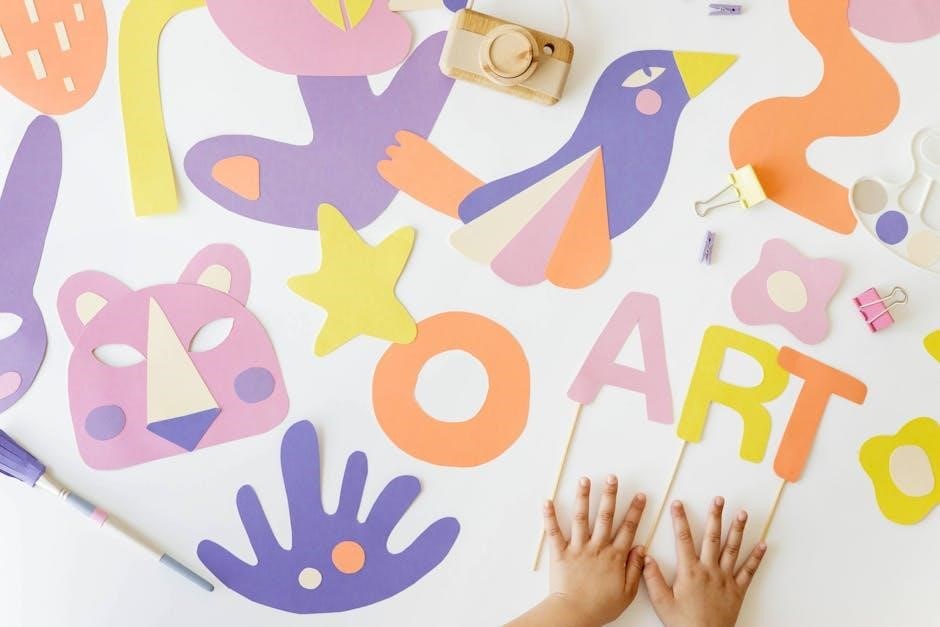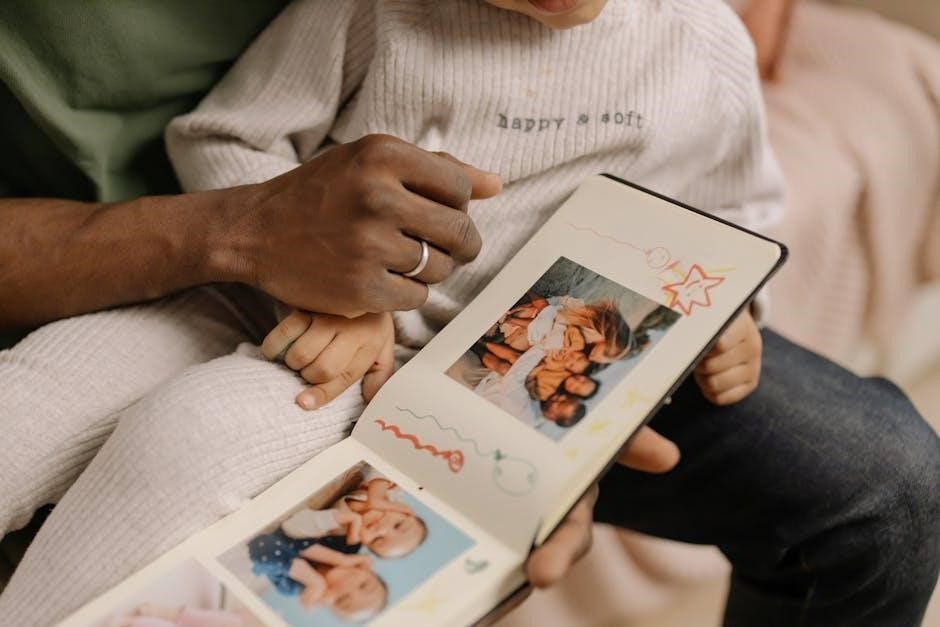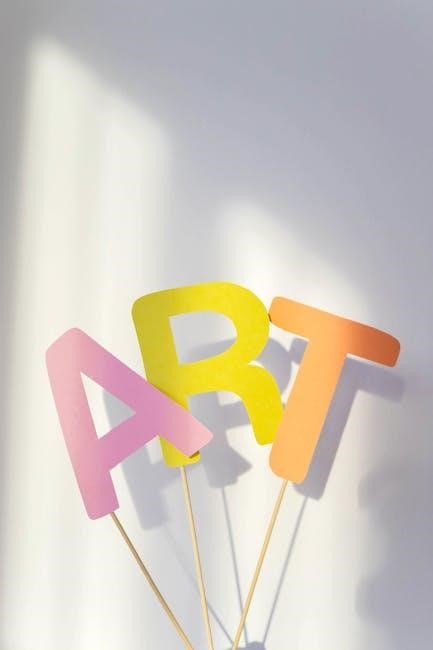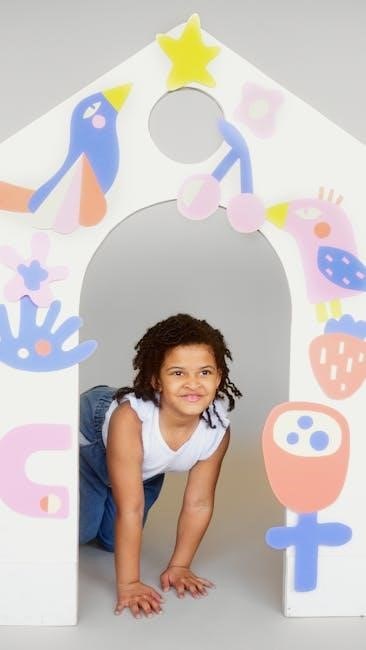The biblical account of creation, spanning seven days, is a foundational story in Genesis. Visual tools like PDFs and pictures enhance learning, making it engaging and interactive.
Overview of the Biblical Account
The biblical account of creation, as described in Genesis, outlines how God created the world in six days and rested on the seventh. Each day focuses on a specific aspect of creation, from light and darkness to land, vegetation, celestial bodies, sea creatures, birds, land animals, and finally humanity. The seventh day symbolizes rest and reflection. Visual tools, such as PDFs and pictures, help illustrate this sequence, making the story engaging and easier to understand for learners of all ages. These resources provide a clear and structured way to explore the creation narrative.
Importance of Visual Learning Tools
Visual learning tools, such as PDFs and pictures, play a crucial role in teaching the 7 days of creation. They help learners, especially children, connect with the biblical narrative by making abstract concepts tangible. Images and diagrams allow for better retention and engagement, as they break down complex ideas into understandable visuals. These tools also cater to diverse learning environments, such as Sunday school or homeschooling, by providing interactive and memorable resources. Incorporating visuals ensures that the story of creation remains vivid and accessible for all ages.
PDF resources offer numerous benefits for teaching the 7 days of creation. They provide a convenient and organized way to share materials, ensuring consistency across different learning environments. PDFs are easily downloadable and printable, making them accessible for various activities. They often include visuals, such as pictures and diagrams, which enhance understanding and engagement. Additionally, PDFs can be used in multiple settings, from classrooms to home activities, making them a versatile tool for educators and parents alike. Their simplicity and accessibility make them an ideal choice for interactive learning experiences. On the first day, God separated light from darkness, creating day and night. Visual PDF resources, including vibrant pictures, help illustrate this foundational moment in creation. Genesis 1:3-5 describes the first day of creation, where God spoke light into existence and separated it from darkness. This foundational passage highlights God’s power and purpose. Visual tools like PDF resources, including vibrant pictures and illustrations, help learners of all ages grasp the significance of this moment. Engaging activities and crafts complement the biblical text, making it easier for children to connect with the story. These resources are perfect for Sunday school, homeschooling, or personal study, offering an interactive and memorable learning experience. Engage students with Day 1 of creation through interactive activities. Use a light and dark sorting game to illustrate God’s separation of light from darkness. Provide a coloring page featuring the Earth before and after light was created. Incorporate a hands-on craft, such as making a mobile with glow-in-the-dark stars, to visualize the first day. These activities, paired with Genesis 1:3-5, help kids understand God’s creative power and the significance of light in His plan. Visuals are key to helping students grasp the concept of Day 1, where God separated light from darkness. Use high-quality images of the Earth before and after light was created. Include before-and-after scenes to illustrate the transformation. Abstract representations of light and darkness, such as glowing orbs or contrasting colors, can also be effective. These visuals, paired with Genesis 1:3-5, create a powerful teaching tool. They help students visualize God’s command, “Let there be light,” and understand its significance in the creation story. Day 2 focuses on the creation of the sky and the firmament. Use pictures and PDFs to show the separation of waters, enhancing the visual storytelling for kids. Genesis 1:6-8 describes God creating the sky, dividing the waters above and below. Visual aids like pictures and PDFs help illustrate the firmament, making the concept clear and engaging for learners. These verses emphasize God’s orderly creation, establishing the sky as a separate domain. Using visual resources enhances understanding, especially for children, by providing a tangible representation of this biblical account. Interactive tools and printables can further enrich the learning experience, making the story of creation both memorable and accessible. Engage children with Day 2 activities by using interactive PDFs and colorful pictures of the sky and firmament. Hands-on crafts, like creating cloud art or building models of the atmosphere, make learning fun. Storytelling with visuals helps kids visualize God’s separation of waters. Interactive worksheets and games reinforce the concept, while group discussions encourage deeper understanding; These activities make the biblical account relatable and memorable for young learners, fostering a connection with the creation story. Vibrant pictures and PDF illustrations of the firmament bring Day 2 of creation to life. These visuals depict the sky separating the waters above and below, creating a clear division. Colorful images of clouds, birds, and the vast expanse of the atmosphere help children visualize God’s work. High-quality illustrations in printable formats make it easy to share these visuals in classrooms or homes. These resources enhance storytelling and provide a tangible way for kids to connect with the biblical account of the firmament’s creation. The third day focuses on the emergence of land and vegetation, with vivid pictures and PDF resources helping to illustrate God’s creative process. Genesis 1:9-13 describes the third day of creation, where God separates the waters and forms dry land. The text highlights the emergence of vegetation, with plants yielding seeds and trees bearing fruit. This passage emphasizes God’s command, “Let the land produce vegetation,” and the resulting abundance of plant life. The use of vivid pictures and PDF resources can help visualize this transformative day, making it easier for learners to grasp the biblical account. These visual tools also support interactive activities and crafts, enhancing the teaching experience. Engage learners with creative crafts representing Day 3 of creation, focusing on land and vegetation. Activities include creating 3D landscapes with clay or paper mache, crafting paper plate earths, and designing gardens with colored seeds. These hands-on projects help visualize Genesis 1:9-13, where God formed dry land and abundant plant life. PDF templates and guides offer step-by-step instructions, making it easy for educators to prepare materials. These crafts not only enhance understanding but also make the biblical account memorable and fun for participants of all ages; Visualizing Day 3 of creation is made easier with stunning pictures of plants and landforms. These images depict the emergence of dry land, lush vegetation, and diverse flora as described in Genesis 1:9-13. From towering mountains to vast gardens, these visuals bring the biblical account to life. PDF resources offer high-quality illustrations, perfect for teaching and activities. They include vibrant flowers, trees, and landscapes, helping learners connect with the creation story. These images are ideal for enhancing lessons and crafts, making the third day of creation engaging and memorable for all ages. Genesis 1:14-19 describes the creation of the sun, moon, and stars to provide light and mark time. Visuals in PDFs showcase celestial beauty, aiding in biblical storytelling. Genesis 1:14-19 recounts the fourth day of creation, where God formed the sun, moon, and stars to provide light and regulate time. These celestial bodies were created to serve as signs and seasons, showcasing God’s order and purpose. Visual representations in PDFs, such as diagrams of the solar system or illustrations of day and night, help learners grasp the biblical account. These resources make the story engaging, especially for children, by combining scripture with imagery that highlights the beauty and functionality of creation. Engage kids with hands-on activities that bring the creation story to life. Use PDF printables to create sequencing cards, where children arrange the days in order. Incorporate puzzles and matching games featuring images of celestial bodies, plants, and animals. Crafts like paper plate suns or handprint trees can visually represent each day’s creation. Interactive worksheets with fill-in-the-blank verses from Genesis 1:14-19 help reinforce memory. Group discussions and role-playing activities encourage deeper understanding and participation, making learning both fun and meaningful. Visual aids like PDF printables and images are essential for teaching Day 4 of creation. Pictures of the sun, moon, and stars help children visualize Genesis 1:14-19. Use vibrant illustrations of glowing suns and starry skies to captivate young learners. Stock videos of celestial movements can also enhance understanding, showing how these bodies provide light and govern time. These visuals make abstract concepts tangible, helping kids connect with the Bible’s account of creation. Incorporate these tools to create engaging and memorable lessons. Genesis 1:20-23 describes the creation of sea creatures and birds. Use colorful PDF pictures to show diverse marine life and flying creatures, making lessons engaging and memorable. Genesis 1:20-23 recounts the fifth day of creation, where God created sea creatures and birds. PDF resources and pictures bring this story to life, showing diverse marine life and flying creatures. Engage kids with interactive activities that explore the fifth day of creation. Use PDF printables to create colorful marine life coloring pages, featuring fish and birds. Organize crafts where children can assemble underwater dioramas using cutouts from creation pictures. Conduct matching games to identify sea creatures and birds, reinforcing their understanding of Genesis 1:20-23. Storytelling sessions with visual aids can deepen their connection to the biblical account. Hands-on activities like making fish-shaped snacks or bird feeders add a tactile, fun dimension to learning about God’s creation. Engage children with vibrant pictures of birds and fish, representing the fifth day of creation. These visuals bring Genesis 1:20-23 to life, showcasing God’s diverse marine and avian creations. PDF resources offer a wide range of colorful illustrations, from playful dolphins to soaring eagles. Use these images in crafts, coloring activities, or interactive games to help kids connect with the biblical account. The bright designs capture young imaginations, making the story of creation both memorable and enjoyable. These visuals are perfect for enhancing lessons and sparking curiosity about God’s creative masterpiece. On the sixth day, God created land animals and humanity in His image (Genesis 1:24-31). Vibrant pictures and PDF resources depict diverse animals and the creation of Adam and Eve, helping children visualize this pivotal day. These visuals enhance storytelling and interactive learning, making the biblical account engaging and memorable for young minds. Genesis 1:24-31 describes the sixth day of creation, where God created land animals and humanity. The passage emphasizes that God made each animal “according to their kind” and formed humans in His own image (Genesis 1:27). This day is significant as it highlights the culmination of creation, with humans being given dominion over the earth. Pictures and PDF resources illustrating diverse animals and the creation of Adam and Eve can help visualize this pivotal moment, making the biblical account engaging and educational for learners of all ages. Teaching the story of Adam and Eve, created on the sixth day, helps students understand humanity’s purpose and God’s relationship with us. Using pictures and PDF resources, educators can illustrate the creation of the first humans and their role in God’s plan. Activities like coloring pages and crafts can engage kids, while worksheets reinforce key lessons. Visual aids, such as images of the Garden of Eden, make the story relatable and memorable, emphasizing themes of stewardship and the unique creation of humanity in God’s image. Visual representations of animals and humans from the sixth day of creation bring the biblical account to life. Pictures of diverse land animals, such as lions, elephants, and cattle, help illustrate God’s creative power. Images of Adam and Eve, the first humans, emphasize their unique role as stewards of the Earth. These visuals, often included in PDF resources, make the story engaging for children and adults alike. Coloring pages and crafts featuring these images allow learners to interact with the narrative, fostering a deeper understanding of God’s design and purpose for humanity and the animal kingdom. On the seventh day, God rested, setting an example for humanity. Pictures of peaceful landscapes and calm scenes symbolize this sacred day of reflection and renewal, enhancing understanding through visual learning. Genesis 2:2-3 describes the culmination of creation, where God rested on the seventh day, blessing and sanctifying it. This passage emphasizes the significance of rest and reflection, mirroring God’s action. Pictures and PDF resources illustrating serene landscapes and peaceful scenes help visualize this sacred day, making the biblical account more relatable and engaging for learners. These visuals, often included in educational materials, reinforce the concept of rest as a divine example for humanity, fostering a deeper understanding of its importance in spiritual and physical well-being. Teach the concept of rest through engaging activities like creating a “Rest Day” collage or discussing ways to unwind. Use PDF resources with pictures of peaceful scenes to spark conversations. Interactive worksheets and coloring pages featuring serene landscapes can help kids visualize God’s rest. Hands-on crafts, such as making paper doves or rainbows, symbolize peace. These activities encourage reflection and help children grasp the importance of rest, aligning with the biblical account of Day 7. They also foster a deeper appreciation for the value of stillness and renewal in daily life; Pictures of serene landscapes, such as calm waters, fluffy clouds, and lush greenery, help illustrate the concept of rest. Symbols like doves, rainbows, and the Earth from space evoke feelings of tranquility. These visuals complement PDF resources by providing a tangible connection to the biblical account of God’s rest on the seventh day. Such images are ideal for activities, crafts, and discussions, making the story relatable and engaging for learners of all ages. They serve as powerful tools to convey the essence of peace and renewal in creation. Free PDF printables and interactive creation tools offer engaging ways to teach the biblical account. These resources include puzzles, games, and visual aids to enhance learning experiences for all ages. Free PDF printables for each day of creation provide engaging activities for kids. These include coloring pages, puzzles, and memory verses. Each PDF is designed to be easily downloaded and printed, making them perfect for homeschooling or Sunday school. The activities are tailored to help children understand and remember each day’s events, from the separation of light to God’s rest on the seventh day. Visual elements and hands-on tasks make learning fun and interactive, ensuring a deeper connection to the biblical account. Interactive worksheets and games are excellent tools for teaching the 7 days of creation. These resources include matching games, crossword puzzles, and sequencing activities that help kids remember the order of creation. Each worksheet is designed to be engaging and educational, often accompanied by visuals and biblical references. Games like “Creation Day Matching” and “Genesis Timeline” make learning fun while reinforcing the story. These activities are perfect for homeschooling, Sunday school, or family time, ensuring kids actively participate in understanding the biblical account of creation. Visual aids are essential for teaching the 7 days of creation effectively. High-quality images, diagrams, and illustrations help students visualize each day’s events, making the story more relatable. PDF resources often include pictures of light, sky, land, plants, celestial bodies, sea creatures, animals, and humans, aligning with each creation day. These visuals can be projected in class or printed for worksheets, ensuring engaging and interactive lessons. They cater to different learning styles, helping kids connect with the biblical narrative in a meaningful way. Visual aids also make complex concepts easier to understand and remember. Engage kids with fun activities like coloring pages, crafts, and interactive games. PDF resources offer easy-to-print materials, fostering creativity and a deeper understanding of the creation story. Engage kids with 7 Days of Creation coloring pages, each designed for a specific day. These PDF printables offer vibrant visuals, making learning fun and interactive. Day 1 features light and darkness, while Day 7 showcases the Earth at rest. Children can color birds on Day 5 and animals on Day 6, reinforcing their understanding. Perfect for homeschooling or Sunday school, these pages simplify complex concepts. They also align with activities like crafts and memory verses, ensuring a well-rounded educational experience. The Earth Day connection adds an environmental twist, making it versatile for various teaching settings. A Story Planner PDF is an excellent tool for teaching the 7 Days of Creation. It includes images and short descriptions for each day, helping kids visualize the biblical account. Day 1 shows light separating from darkness, while Day 7 depicts rest. This planner is adaptable to various ages and groups, making it ideal for classroom or home use. Teachers can use it to create engaging lessons, while parents can incorporate it into family activities. The visual storytelling enhances comprehension and retention, making the creation story memorable for young learners. Enhance learning with memory verses and worksheets tailored for the 7 Days of Creation. These resources include key Bible verses in KJV, perfect for memorization. Worksheets offer interactive activities, such as fill-in-the-blanks and matching games, to reinforce understanding. They are designed to be adaptable for different age groups and learning environments. The combination of biblical text and engaging exercises helps children commit the creation story to memory while fostering a deeper connection to the narrative. These tools are ideal for Sunday school, homeschooling, or personal study, making learning fun and meaningful. Pictures are a powerful tool for engaging students with the 7 Days of Creation. Visuals bring the story to life, making it easier for children to understand and remember the sequence of events. From the separation of light to the creation of humanity, images provide a tangible connection to the biblical narrative, fostering deeper comprehension and interest in the subject. Stock videos and footage offer dynamic visuals for the 7 Days of Creation, bringing the biblical story to life. From the separation of light to the creation of humanity, these clips provide engaging content for presentations, educational materials, and social media. Videos can be adapted to various learning environments, enhancing the storytelling experience. Many clips are available for free or with attribution, making them accessible for educators and creators. They cater to diverse needs, ensuring visual learning is both impactful and inspiring for students of all ages. Engage kids with creative art and craft projects that illustrate the 7 Days of Creation. Use PDF printables to design colorful crafts, such as paper plate firmaments for Day 2 or handprint trees for Day 3. Activities like making clay animals for Day 6 or painting the sun, moon, and stars for Day 4 foster creativity. Interactive projects, such as building a creation diorama or sequencing the days with visual aids, help children remember the story. These crafts make learning fun and hands-on, perfect for Sunday school or homeschooling. Enhance your 7 Days of Creation lessons with engaging presentations and social media content. Use PDF printables to create visually appealing slides, incorporating images of each day’s creation. Stock videos and footage can add dynamic elements to your presentations. Share highlights on social media using colorful pictures and infographics, perfect for capturing attention. Include short summaries or memory verses to make posts educational and inspiring. These resources help spread the story creatively while encouraging others to explore the biblical account of creation. The 7 Days of Creation conclude with a powerful story of divine completion. Visual tools like PDF resources and images make the biblical account engaging and memorable for learners of all ages. The seven days of creation, as described in Genesis, outline how God systematically created the world. Day 1 brought light; Day 2, the sky; and Day 3, land and vegetation. Days 4–6 introduced celestial bodies, sea creatures, birds, land animals, and humanity. Day 7 was a day of rest. PDF resources and images help illustrate each day, making the story accessible and engaging for learners. These visual tools provide a comprehensive overview, fostering a deeper understanding of the biblical account. Exploring the seven days of creation can spark curiosity and deepen faith. Using PDF resources and pictures, learners can engage with the story visually and interactively. Encourage children to ask questions, reflect on each day’s significance, and connect the creation story to their daily lives. Activities like coloring pages, crafts, and storytelling can foster a lifelong interest in biblical teachings. By making learning fun and meaningful, these tools help children grow in their understanding and appreciation of God’s creative work. Visual learning is a powerful method for teaching the seven days of creation. PDF resources and pictures provide engaging tools that cater to different learning styles, making the story memorable for children. By incorporating coloring pages, crafts, and interactive activities, educators can help kids connect with the biblical narrative on a deeper level. These resources not only enhance understanding but also inspire creativity and reflection, making the learning process enjoyable and impactful for young minds.Benefits of Using PDF Resources

Day 1: Separation of Light and Darkness
Genesis 1:3-5
Activities for Teaching Day 1
Visuals and Pictures for Day 1

Day 2: Creation of the Sky
Genesis 1:6-8
Engaging Kids with Day 2 Activities
Illustrations of the Firmament

Day 3: Land and Vegetation
Genesis 1:9-13
Hands-On Crafts for Day 3
Pictures of Plants and Landforms

Day 4: Sun, Moon, and Stars
Genesis 1:14-19
Interactive Learning Ideas
Visual Representations of Celestial Bodies

Day 5: Sea Creatures and Birds
Genesis 1:20-23
These verses highlight God’s command for the waters and skies to teem with life, emphasizing His creative power. Visual aids like colorful PDF printables and images of birds and fish help children engage with the story. Activities such as coloring and crafts can reinforce the lesson, making it interactive and memorable for young learners. This day showcases God’s abundance and variety in creation.Activities for Exploring Marine Life
Colorful Pictures of Birds and Fish

Day 6: Land Animals and Humanity
Genesis 1:24-31
Teaching About Adam and Eve
Images of Animals and Humans
Day 7: Rest and Reflection
Genesis 2:2-3
Activities for Understanding Rest
Pictures Symbolizing Peace and Rest

Teaching Resources and Tools
Free PDF Printables for Each Day
Interactive Worksheets and Games
Visual Aids for Classroom Use

Engaging Activities for Kids
Coloring Pages for Each Day
Story Planners with Images
Memory Verses and Worksheets

Using Pictures to Enhance Learning
Stock Videos and Footage Options
Art and Craft Ideas
Presentations and Social Media Sharing
Encouraging Continued Exploration
Final Thoughts on Visual Learning
